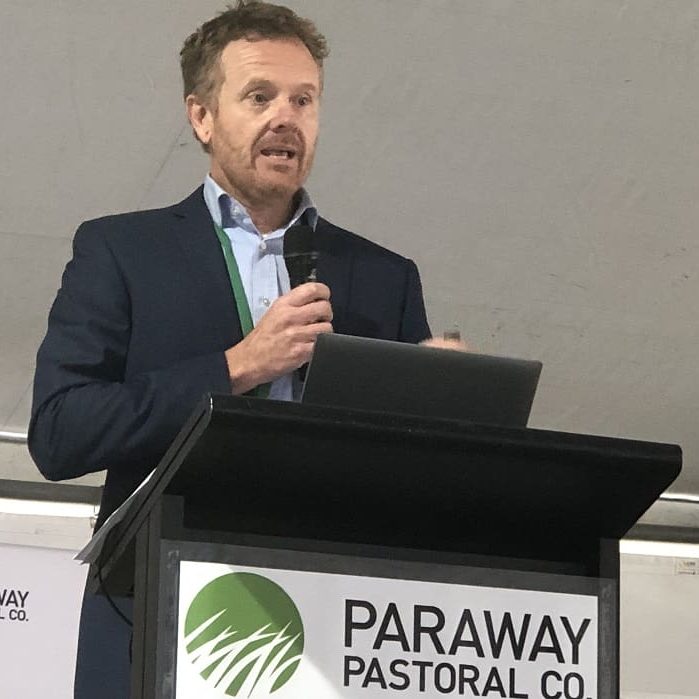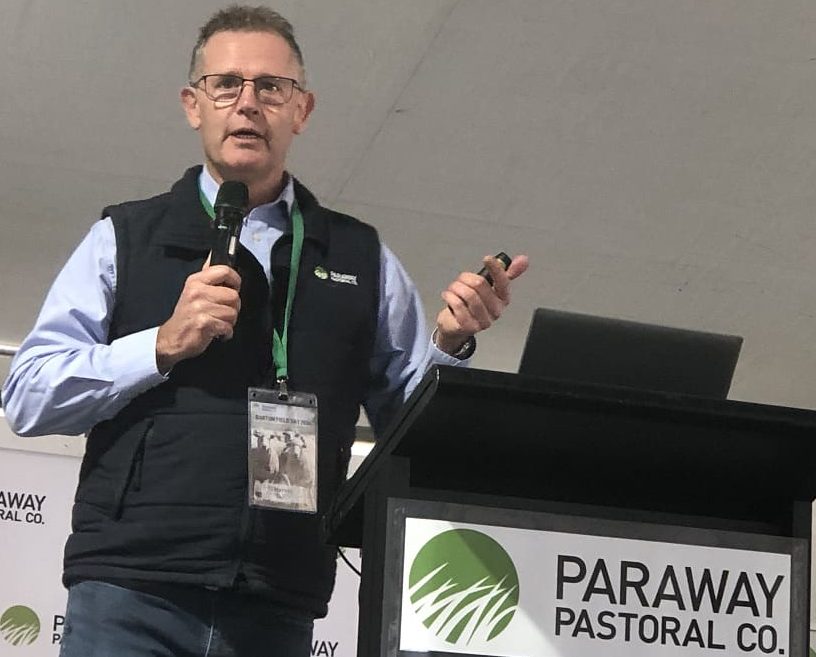MAXIMISING livestock production per hectare, green and solar energy, and electric motorbikes are among the initiatives being used by the Paraway Pastoral Co to achieve emissions intensity goals.
These were outlined to farmers at the company’s ‘Net Zero: Better for Business’ field at its Barton Station Brierly property near Willaura in western Victoria yesterday.
The company has pledged to cut its on-farm methane intensity by at least 30 per cent by 2030, in line with the Global Methane Pledge, getting to net zero by 2040, a decade ahead of the Paris Agreement goal.

Paraway Pastoral Co natural capital manager Paul McDougall
Paraway natural capital manager Paul McDougall said the company from a baseline year of 2021 has a 2040 net zero plan, with an interim 2030 target. This has involved adopting targets for non-livestock emissions and taking an “absolute reduction” approach for non-livestock emissions.
“We are going to reduce those emissions with a baseline of 2021 and record and calculate annually.
“Our 2030 target of a 15 percent reduction, upping that to 35pc with on-farm insetting through vegetation and potentially soil carbon, with a 2040 target to reduce these emissions by 55 pc,” he said.
On the livestock side, Mr McDougall said Paraway has taken an emissions intensity approach, which is reducing the emissions per kilogram produced.
“We’ve also taken the approach of adopting a five-year average, both in the baseline and as we go forward.
“Now again with that 2030 reduction target we could only use technologies that were available and calculatable at the time, which was pretty much production gains,” he said.
“We’ve said 10 percent reduction which we would up to 30 percent to align with our Global Methane Pledge and by 2030 we believe we can get to 30pc across the board … and potentially further.”
Mr McDougall said Paraway has been able to significantly reduce its electricity use, already below its 2030 target, helped by the purchase of green power. Diesel use is problematic, but is almost at its 2030 target and it is hoped with further initiatives this will be achieved.
He said electric bikes have been introduced in New South Wales and Queensland, and after some hesitation the managers are onside.
“Even in western Queensland in the channel country up in the gulf, where they said it’s not going to be appropriate, they’re finding that they are the most popular bikes.
“They’re doing a lot of conversions of diesel and electric bores to solar,” he said.
Diesel station generators are being converted to solar-hybrid systems and the company has purchased its first electric buggy.
Mr McDougall said the company’s baseline emissions intensity from 2017-2021 were calculated using the GAP tool, including scope 1 emissions and scope 3 emissions for purchased livestock. But a five-year average was adopted because of an “unacceptable” 31pc variability due to seasonal issues and sales timings between individual years.
“It gives a better idea of the direction in which are going – so our baseline emissions were 12.88kg of CO2 equivalent per kilo we produce.”
In 2023, he said Paraway’s emissions intensity increased 13pc to 14.57kg/CO2 driven mainly by rain at end of 2022 that prevented the removal of cattle from the company’s channel properties, but the five-year average only changed 5pc.
The company is also focusing on livestock genetics, “trying to get the right animal in the right environment.”
“Having our genetic strategy and sticking to it and focusing on fertility and growth, being ruthless in our culling of unproductive animals, by monitoring our growth rates using things like OptiWeigh and drafting into tight groups so that animal are only on the farm as long as they need to be,” he said.
“We are maximizing pasture growth and maximising animal performance and trialling artificial insemination technology using sexed semen at a few stations.
Mr McDougall said the first 38 Angus heifers artificially inseminated with sexed semen produced all male calves.
“The males calves will grow on average 0.1kg ADD (average daily weight gain) faster than the heifers and will therefore have an emissions intensity 10pc less.”
The company is working on carbon sequestration by planting trees and maximising soil carbon, with the help of Landcare and other groups. A station-by-station approach is being taken with woody vegetation.
“Some of our properties just have no capacity to grow forests,” Mr McDougall said.
He said Barton Station was purchased in 2018 and has a shorter baseline period, but has already overshot its 2030 target and well on the way to get to the Global Methane Pledge target.
“This is through a focus on productivity … a really really relentless focus on productivity.”
Cow foetus aging allows for differential management
Farmers at the Barton field day were given a detailed insight into how sheep and cattle are managed to maximize producer by manager Robert Cooper
He said the 8200 ha property is in a 600mm rainfall zone, and currently running 2900 pregnancy-tested in-calf Angus cows as well as 13,500 adult composite ewes, 5000 first cross ewes and this year 7000 composite ewes lambs.
The winter-calving self-replacing herd’s cows are joined to Angus bulls, except for the heifers that calve as two year-olds to the Wagyu.
He said at 12 weeks the adult cows’ foetuses are aged to allow early mid and late joined cows to be identified for more efficient feed budgeting and to allow agistment or sale decisions in a dry autumn or spring. A database is being compiled with each cow’s pregnancy test result for the last four years to track fertility.
Heifers are joined for nine weeks and foetuses are aged into two groups to allow monitored calving and feed budgeting, Mr Cooper said. Bulls are purchased to maintain a moderately sized cow herd, with top 50pc growth and top 25pc intramuscular fat breeding values. Calves are weaning from late February to the end of March.
Weaners go to a containment area to be fed a silage and cracked grain ration until May when steers and Wagyu cross calves are sold. Heifers are agisted on company properties if the season allows, Mr Cooper said.
“The aim is to get the Angus steers to 300kg and the Wagyu cross cattle to 250kg.”
Rotationally grazing cows has enabled them to eat the bulk of the carryover spring feed over summer to open up the pasture sward and allow sub clover germination.
A 60 percent stocking rate increase in five years
Mr Cooper said adult ewes are split joined — in late January and late February — to mitigate risk of bad weather at joining ie hot weather, or more importantly at lambing time. Ewes are teased with vasectomized rams for 14 days and joined for 17 days. Retained adult ewes all scanned pregnant as ewe lambs.
“No empty ewe lambs are kept.”
“This consolidated joining helps with pasture management, dealing with a bad autumn and evenness of lambs at weaning,” Mr Cooper said.
He said pregnancy scanning identifies singles, twins and triplets. Lambs are grain-trained on their mothers and weaned at 42 days. Ewe are joined for 17 days, then have 14 days off, before being rejoined for 17 days. Ewe lambs are joined for 35 days to lamb in August. Replacement ewe lambs are regularly weighed to ensure liveweight gain is sufficient for joining at 7.5 months, he said. Rams are purchased with a focus on reproductive traits; yearling conception, ewe rearing ability and weaning weight.
Mr Cooper said adult ewe scanning results have been good this year – averaging 168pc rescanning after second 17-day joining — but the trick will be lambing in the very late season.
He said Barton is undergoing an extensive development program to make paddocks smaller, increase shelter and environmental diversity through plantations, and deliver reticulated water to paddocks, and lower carbon intensity.
“Decreasing the paddock size enables better pasture management and facilitates better survival rates through running smaller mobs,” he said.
“Paddocks are being cut from 60 he to 30 ha and stocking rates will increase as better utilisation of the available pasture occurs.”
He said fencing waterways will decrease erosion and improve water quality.
Mr Cooper said his pasture management aims to grow and utilize as much as possible leaving 600-800kgDM/ha before autumn break occurs to promote sub clover germination. He said pasture is the single largest expense in the Barton budget, but has led to a 60 percent increase in stocking rate in the last five years alone. New pastures are Holdfast phalaris with a clover mix. Ryegrass as also been used in the southern end of the farm but is being phased out due to persistence issues.
As part of achieving the increased stocking rate, containment areas and holding paddocks are used to hold sheep and cattle during dry autumns.
“This system is fully stocked now allowing whatever rainfall we do receive to grow as much of the lambing platform this year as possible.”
Mr Cooper said lucerne has proven valuable by extending the shoulder of the season into early summer and taking advantage of any summer rainfall. Excess pasture is put into pit silage to form the base containment ration with barley or beans for extra energy and protein.
Efficiency gains have also been made with short joining and early weaning and managing to condition score, he said.
“These practices and related feed budgeting has resulted in a better condition score on our ewes going into summer which has translated into less supplementary feeding and better scanning results.”
He said standard practice three years ago was a 35-day joining for ewes and a 65-day weaning of lambs. Barton’s current practices give ewes 41 days post-weaning in the peak of spring to put condition back on without supplementary and feed can be prioritised for the weaned lambs.
Mr Cooper said addressing soil fertility issues has been important in increasing DM production which has led to higher carrying capacity.
Rotational grazing of large mobs of weaned ewes in late August has benefited pasture growth rates and increased weight gain in the ewe flock.
Semi portable cattle yards and portable sheep yards have limited the amount of droving required for routine processes like calf and lamb marking, Laneways have also increased efficiency.
Income from carbon biodiversity and renewable energy – Gaynor

Paraway Pastoral Co chief executive officer Harvey Gaynor
Paraway chief executive officer Harvey Gaynor said Paraway is a diverse agricultural land management business focused on meat and wool production, with irrigated and dryland cropping operations, from the gulf to the Grampians in Victoria on over 30 stations with 250 people working on farm.
“Increasing we see income coming into our business now and in the future through sequestering carbon, through biodiversity credits and through hosting renewable energy projects.
“I think that is part of the future for us as ag land managers and probably the same for many of you in the room.”
Mr Gaynor said there are 30 people in the company’s southern region, with property managers led by regional general manager Sarah Roche. He said Barton is one of the company’s most intensive production properties and an important part of Paraway’s carbon story.
He said the emissions that are generated through Paraway’s activities have global impacts and that’s why businesses around the planet are trying figure out how to do things differently in the future.
“Certainly it is how our investors think about it – they ask us about this all the time, they are very supportive of what we are doing.
“Most of the people who are ultimately invested in Paraway, the fund that owns Paraway, they are pension fund investors, they are superannuates around the world, who have an interest in the future of the planet and so they want to see this stuff happening, just as we do.”

HAVE YOUR SAY